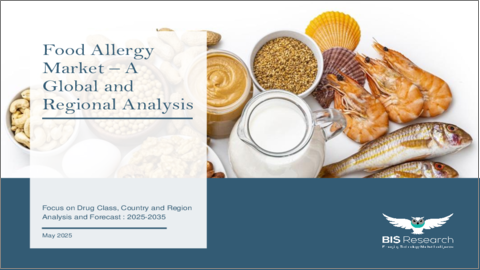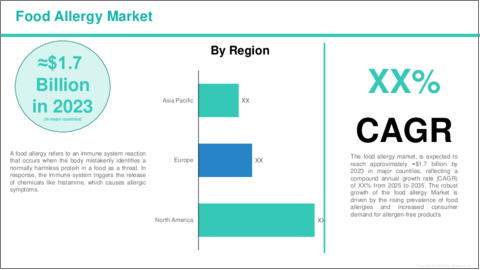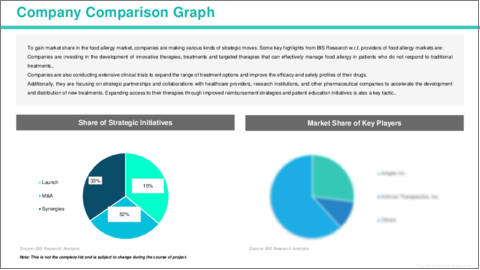|
|
市場調査レポート
商品コード
1729047
食物アレルギー市場- 世界および地域別分析:薬剤クラス別、国別、地域別 - 分析と予測(2025年~2035年)Food Allergy Market - A Global and Regional Analysis: Focus on Drug Class, Country, and Region - Analysis and Forecast, 2025-2035 |
||||||
カスタマイズ可能
|
|||||||
| 食物アレルギー市場- 世界および地域別分析:薬剤クラス別、国別、地域別 - 分析と予測(2025年~2035年) |
|
出版日: 2025年05月21日
発行: BIS Research
ページ情報: 英文 100 Pages
納期: 1~5営業日
|
全表示
- 概要
- 図表
- 目次
食物アレルギーの発生件数の増加、消費者の意識の高まり、診断・治療方法の技術進歩が食物アレルギー市場の成長の主な促進要因です。
食物アレルギーは世界的に重大な関心事であり、数100万人に影響を及ぼし、効果的な治療オプションに対する需要の高まりにつながっています。
食物アレルギーは、免疫系が無害な食物タンパク質を有害なものと誤認することで発生します。症状は軽度のものから生命を脅かすものまで様々であり、効果的な治療と予防措置の必要性が強調されています。免疫療法やその他の生物製剤の進歩は、患者の転帰を改善する上で重要な役割を果たしています。
市場のライフサイクル段階
食物アレルギー市場は、経口免疫療法、生物学的製剤、アレルゲンに対する患者の減感作を目的とした遺伝子組み換え製品など、新たな治療オプションへの多額の投資によって進化段階にあります。対症療法からより予防的な治療へのこのシフトは、市場のライフサイクルにおける極めて重要なポイントを示しています。
食物アレルギーの世界市場は薬剤クラス別に区分され、各クラスは食物アレルギーの異なる側面に対応しています。抗ヒスタミン薬は軽度の症状に対する治療薬として人気が高く、安定した市場需要に貢献しています。炎症管理に使用されるステロイドと呼吸器症状の緩和に役立つβ2-アゴニストも重要なセグメントであり、食物アレルギーの症状管理における補完的な役割により、緩やかな成長が見込まれています。
北米が食物アレルギーの世界市場で最大のシェアを占めており、米国が大きく貢献しています。
需要- 促進要因と限界
食物アレルギーの世界市場は、いくつかの重要な要因によって牽引されています:
- 小児および成人における食物アレルギーの世界の増加により、予防および治療手段に対する需要が高まる可能性が高い
- 研究開発への注力の強化が、高度なアレルギーケア製品の需要に大きく貢献すると予想される
- ヘルスケア支出の増加とインフラへの政府投資が食物アレルギー市場の成長を後押しする
限界:
- 標準化された診断基準がないため、食物アレルギーの有病率と管理に関するエビデンスが限られています。
- 検査結果の遅れと大量の血液サンプルの必要性(特に小児の場合)が市場の成長を阻害する可能性があります。
- 治療中の重篤な副作用のリスク
製品/イノベーション戦略:当レポートは、食物アレルギーの治療と診断サービスにおける主な動向をハイライトし、企業が食物アレルギー患者に合わせた生物学的製剤、免疫療法、精密医療でイノベーションを起こすのに役立ちます。
競合戦略:食物アレルギー市場は競争が激しいため、製薬企業、ヘルスケアプロバイダー、食品メーカーは当レポートを活用して、市場動向、競合他社、新たな機会を理解することで、優位に立つことができます。
主要市場参入企業と競合情勢
当レポートで紹介する企業は、専門家の洞察に基づき、企業カバー率、製品ポートフォリオ、市場浸透度を評価して選定しています。世界の食物アレルギー市場における主要企業には、製薬会社、ヘルスケアプロバイダー、食品メーカーなどが含まれます。
当レポートでは、世界の食物アレルギー市場について調査し、市場の概要とともに、薬剤クラス別、国別、地域別の動向、および市場に参入する企業のプロファイルなどを提供しています。
目次
第1章 世界の食物アレルギー市場:業界見通し
- 市場概要とエコシステム
- 食物アレルギーの疫学的分析
- 米国
- EU5か国
- その他の地域
- 市場動向
- 臨床試験
- 相別
- 規制状況分析
- 米国における法的要件と枠組み
- EUにおける法的要件と枠組み
- アジア太平洋における法的要件と枠組み
- その他の国における法的要件と枠組み
- 市場力学
第2章 世界の食品アレルギー市場(薬剤クラス別、100万米ドル、2023年~2035年)
- エピネフリン
- 抗ヒスタミン薬
- ステロイド
- その他
第3章 世界の食物アレルギー市場(地域別、100万米ドル、2023年~2035年)
- 北米
- 欧州
- アジア太平洋
第4章 世界の食物アレルギー市場-競合ベンチマーキングと企業プロファイル
- 競合情勢
- 各社の主要戦略と展開
- 主な発展分析
- 企業プロファイル
- Novartis Pharmaceuticals
- F. Hoffmann-La Roche Ltd
- DBV Technologies
- Vedanta Biosciences, Inc
- Regeneron Pharmaceuticals
- Camallergy
第5章 調査手法
List of Figures
- Figure: Global Food Allergy Market, Coverage
- Figure: Global Food Allergy Market, Key Trends, Impact Analysis
- Figure: Global Food Allergy Market, Competitive Landscape, January 2022-April 2025
List of Tables
- Table: Global Food Allergy Market, Dynamics and Impact Analysis
- Table: Global Food Allergy Market, Regulatory Landscape
- Table: Global Food Allergy Market, (by Drug Class), $Million, 2023-2035
- Table: Global Food Allergy Market, (by Region), $Million, 2023-2035
Global Food Allergy Market: Overview
Rising incidences of food allergies, growing awareness among consumers, and technological advancements in diagnostic and treatment methods are the primary drivers of market growth. Food allergies are a significant concern globally, affecting millions of individuals and leading to a growing demand for effective treatment options.
Food allergies occur when the immune system mistakenly identifies a harmless food protein as harmful. Symptoms can range from mild to life-threatening, highlighting the need for effective treatments and preventive measures. Advances in immunotherapy and other biologics are playing an important role in improving patient outcomes.
Market Lifecycle Stage
The food allergy market is in an evolving phase with substantial investment in new treatment options, such as oral immunotherapy, biologics, and genetically engineered products aimed at desensitizing patients to allergens. This shift from symptom management to more preventive treatments marks a pivotal point in the market's lifecycle.
Market Segmentation for the Global Food Allergy Market
Segmentation 1: by Drug Class
- Epinephrine
- Antihistamines
- Steroids
- Others
The global food allergy market is segmented by drug class, with each class addressing different aspects of food allergies. Antihistamines as a popular treatment for mild symptoms, contributing to consistent market demand. Steroids, used for managing inflammation, and Beta-2-agonists, which help alleviate respiratory symptoms, are also important segments, with moderate growth expected driven by their complementary roles in managing food allergy symptoms.
Segmentation 2: by Region
- North America
- Europe
- Asia-Pacific
North America holds the largest share in the global food allergy market, with the U.S. being a major contributor.
Demand - Drivers and Limitations
The global food allergy market is driven by several key factors:
- The global rise in food allergies among children and adults is likely to drive higher demand for preventive and therapeutic measures
- A stronger focus on research and development is expected to significantly contribute to the demand for advanced allergy care products
- Increased healthcare spending and government investment in infrastructure are boosting the growth of the food allergy market
Limitations:
- The lack of standardized diagnostic criteria limits the evidence on food allergy prevalence and management
- Delays in test results and the need for large blood samples, especially in children, can stifle market growth
- Risk of severe adverse reactions during treatment
How Can This Report Add Value to an Organization?
Product/Innovation Strategy: This report highlights key trends in food allergy treatment and diagnostic services, helping companies innovate in biologics, immunotherapy, and precision medicine tailored to food allergy sufferers.
Competitive Strategy: The food allergy market is highly competitive, and pharmaceutical companies, healthcare providers, and food manufacturers can use this report to stay ahead by understanding market trends, competitors, and emerging opportunities.
Key Market Players and Competition Synopsis
The companies profiled in this report are selected based on expert insights, evaluating company coverage, product portfolio, and market penetration. Leading players in the global food allergy market include pharmaceutical companies, healthcare providers, and food manufacturers.
Table of Contents
Executive Summary
Scope of Study
Definition
Inclusion and Exclusion Criteria
1. Global Food Allergy Market: Industry Outlook
- 1.1 Market Overview and Ecosystem
- 1.2 Epidemiological Analysis of Food Allergy
- 1.2.1 U.S.
- 1.2.2 EU5
- 1.2.3 Rest-of-the-World
- 1.3 Market Trends
- 1.4 Clinical Trials
- 1.4.1 By Phase
- 1.5 Regulatory Landscape Analysis
- 1.5.1 Legal Requirement and Framework in U.S.
- 1.5.2 Legal Requirement and Framework in E.U.
- 1.5.3 Legal Requirement and Framework in Asia-Pacific
- 1.5.4 Legal Requirement and Framework in Rest-of-the-World
- 1.6 Market Dynamics
- 1.6.1 Impact Analysis
- 1.6.2 Market Drivers
- 1.6.3 Market Restraints
- 1.6.4 Market Opportunities
2. Global Food Allergy Market, by Drug Class, $Million, 2023-2035
- 2.1 Epinephrine
- 2.2 Antihistamines
- 2.3 Steroids
- 2.4 Others
3. Global Food Allergy Market, by Region, $Million, 2023-2035
- 3.1 North America
- 3.1.1 Key Findings
- 3.1.2 Market Dynamics
- 3.1.3 Market Sizing and Forecast
- 3.1.3.1 North America Food Allergy Market (by Country)
- 3.1.3.1.1 U.S.
- 3.1.3.1 North America Food Allergy Market (by Country)
- 3.2 Europe
- 3.2.1 Key Findings
- 3.2.2 Market Dynamics
- 3.2.3 Market Sizing and Forecast
- 3.2.3.1 Europe Food Allergy Market (by Country)
- 3.2.3.1.1 Germany
- 3.2.3.1.2 France
- 3.2.3.1.3 Italy
- 3.2.3.1.4 U.K.
- 3.2.3.1 Europe Food Allergy Market (by Country)
- 3.3 Asia-Pacific
- 3.3.1 Key Findings
- 3.3.2 Market Dynamics
- 3.3.3 Market Sizing and Forecast
- 3.3.3.1 Asia-Pacific Food Allergy Market (by Country)
- 3.3.3.1.1 Japan
- 3.3.3.1 Asia-Pacific Food Allergy Market (by Country)
4. Global Food Allergy Market - Competitive Benchmarking and Company Profiles
- 4.1 Competitive Landscape
- 4.1.1 Key Strategies and Developments by Company
- 4.1.1.1 Funding Activities
- 4.1.1.2 Mergers and Acquisitions
- 4.1.1.3 Regulatory Approvals
- 4.1.1.4 Partnerships, Collaborations and Business Expansions
- 4.1.2 Key Developments Analysis
- 4.1.1 Key Strategies and Developments by Company
- 4.2 Company Profiles
- 4.2.1 Novartis Pharmaceuticals
- 4.2.1.1 Company Overview
- 4.2.1.2 Product Portfolio
- 4.2.1.3 Target Customers / End Users
- 4.2.1.4 Key Personnels
- 4.2.1.5 Analyst View
- 4.2.2 F. Hoffmann-La Roche Ltd
- 4.2.2.1 Company Overview
- 4.2.2.2 Product Portfolio
- 4.2.2.3 Target Customers / End Users
- 4.2.2.4 Key Personnels
- 4.2.2.5 Analyst View
- 4.2.3 DBV Technologies
- 4.2.3.1 Company Overview
- 4.2.3.2 Product Portfolio
- 4.2.3.3 Target Customers / End Users
- 4.2.3.4 Key Personnels
- 4.2.3.5 Analyst View
- 4.2.4 Vedanta Biosciences, Inc
- 4.2.4.1 Company Overview
- 4.2.4.2 Product Portfolio
- 4.2.4.3 Target Customers / End Users
- 4.2.4.4 Key Personnels
- 4.2.4.5 Analyst View
- 4.2.5 Regeneron Pharmaceuticals
- 4.2.5.1 Company Overview
- 4.2.5.2 Product Portfolio
- 4.2.5.3 Target Customers / End Users
- 4.2.5.4 Key Personnels
- 4.2.5.5 Analyst View
- 4.2.6 Camallergy
- 4.2.6.1 Company Overview
- 4.2.6.2 Product Portfolio
- 4.2.6.3 Target Customers / End Users
- 4.2.6.4 Key Personnels
- 4.2.6.5 Analyst View
- 4.2.1 Novartis Pharmaceuticals





